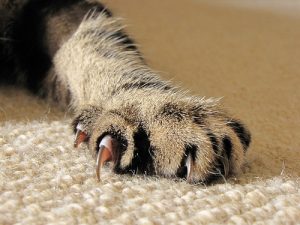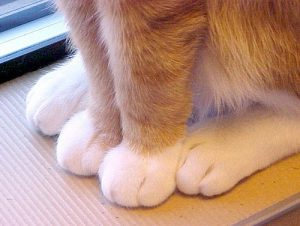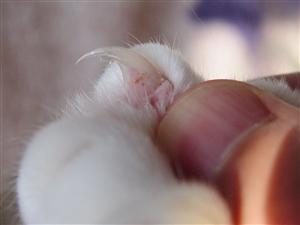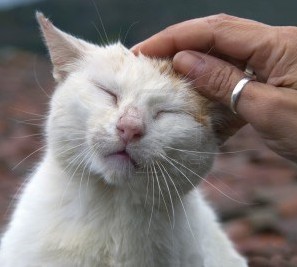How to Trim a Cat’s Claws (or are they Nails?)
Do Cats Have Nails or Claws?
 As professional cat groomers, we get lots of requests to trim cat nails. We know exactly what you mean, but just to set the record straight, technically what cats and dogs have are “claws,” not “nails.” Claws are sharp and pointed and especially useful to catch and hold prey. Nails are flat and don’t grow to a sharp point. We’ve got nails; our pets have claws. Having said that, we’ll use the terms interchangeably since so many people do.
As professional cat groomers, we get lots of requests to trim cat nails. We know exactly what you mean, but just to set the record straight, technically what cats and dogs have are “claws,” not “nails.” Claws are sharp and pointed and especially useful to catch and hold prey. Nails are flat and don’t grow to a sharp point. We’ve got nails; our pets have claws. Having said that, we’ll use the terms interchangeably since so many people do.
Now that we’ve got that burning issue cleared up, have you been wondering how to trim your cat’s nails? The task may seem intimidating at first, but this is definitely something you can do at home. Follow these simple steps and you’ll have your cat’s claws clipped and ready to go in no time.
Begin Clipping Early
To get your favorite feline used to getting their claws trimmed, it’s best to begin at an early age. It’s never too early to practice trimming their claws, and the great thing is, the more often you hold your kitty and get them used to having their paws and toes and claws handled, the easier it will be for everybody involved. Young kittens will be more open to new experiences than older cats, which is why it’s a little easier to start when your cat is young. Plus, young kittens have tiny, thin claws but they can be razor sharp, so you’ll want to keep them trimmed even though they’re young. If you’ve adopted an adult cat, don’t despair, just realize it may take a little longer for both of you to get used to the process.
Get Your Tools Ready
Before starting a nail clipping session, get your tools ready and have them handy. A set of human nail clippers will work just fine as long as they are sharp or you can purchase some cat-specific clippers at a pet store. It’s really important to make sure your clippers are sharp to prevent a nail split or bleed. You may also want to grab a little trash can or plastic bag to gather the clippings.
 Create a Calm Atmosphere
Create a Calm Atmosphere
Choose a setting that is calm and away from things your cat or kitten hates such as running water, sudden loud noises or people roughhousing. We’ve learned that our cat is most calm in the bedroom near her toys. Praise your cat and set the stage for clipping their claws. Speak to your cat in an encouraging voice and don’t speak quickly or with a raised, rushed voice. Take a few moments to pat, stroke and brush your kitty, if she enjoys this kind of attention. Hold each paw and extrude the claws for a minute. It’s really important to create a calm, encouraging atmosphere so that your cat feels comfortable with what is happening.
Take a Firm Grasp and Clip
 Find a position that works best for you and your kitty while cutting her claws. Whether you hold your cat in your lap or nestle your kitten under your arm, it’s important to grasp the cat with a firm hold. Free one hand so that you can apply light pressure to the middle of a paw, fanning the toes out and extruding the claws (this is the part you practice beforehand so that you and your cat are both used to it before you pick up the clippers.)
Find a position that works best for you and your kitty while cutting her claws. Whether you hold your cat in your lap or nestle your kitten under your arm, it’s important to grasp the cat with a firm hold. Free one hand so that you can apply light pressure to the middle of a paw, fanning the toes out and extruding the claws (this is the part you practice beforehand so that you and your cat are both used to it before you pick up the clippers.)
Now, before making the cut, it’s important to locate the pink part of the nail called “the quick.” This part of the nail holds blood vessels and has many nerve endings – so avoid cutting into this area! Just fan out the paw and clip off the top, sharp tip of the claw and no further. Cutting into “the quick” is not life threatening but it is certainly painful and may cause your kitten to bleed. If you do accidentally clip your kitten’s nail too close and cause them to bleed, you can press a bit of styptic powder or cornstarch onto the bleeding tip if needed to help with clotting. Need a little more info on clipping cat claws? Check out this link from WSU’s College of Veterinary Medicine.
It’s not always necessary to cut the claws on the back feet but the front claws should be trimmed regularly – every 2-4 weeks is generally enough, depending on how quickly they grow. A great way to remember to trim your cat’s claws is when you are in need of a clipping yourself. My husband always sits on the floor with our cat and trims his and then the cat’s claws. Although your cat may not love to get their claws trimmed, it’s important to get the job done. And once they’re used to it, they really don’t mind. Just hold them firmly so that your hand doesn’t slip, and always use sharp clippers so that or their claws won’t get split or torn. And don’t fret if you can’t get all the claws trimmed at once. At the beginning, the one-paw-per-day plan may be all your kitty has the patience for. This definitely takes practice, and will get easier the more you do it.
 Reward Great Behavior
Reward Great Behavior
Last but not least, reward your cat’s cooperation with the whole process. Offer up lots of patting or their favorite treats once your session is over. Your cat will learn to look forward to being done and may cooperate better while you cut their claws if they know a treat is on the way. If you don’t reward your cat with treats, then take time to play with them with their favorite toy or do some other activity you know your loves. The idea is to reinforce the positive associations with their nail trimming session. It won’t hurt to pat yourself on the back too! Before you know it, you’ll be clipping claws like a pro, and your cat won’t mind a bit.
